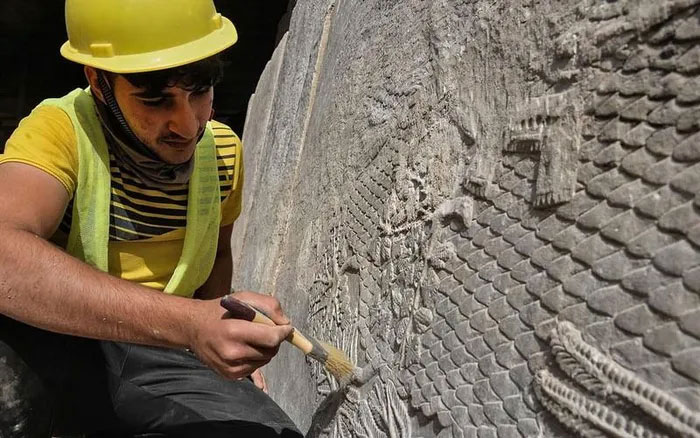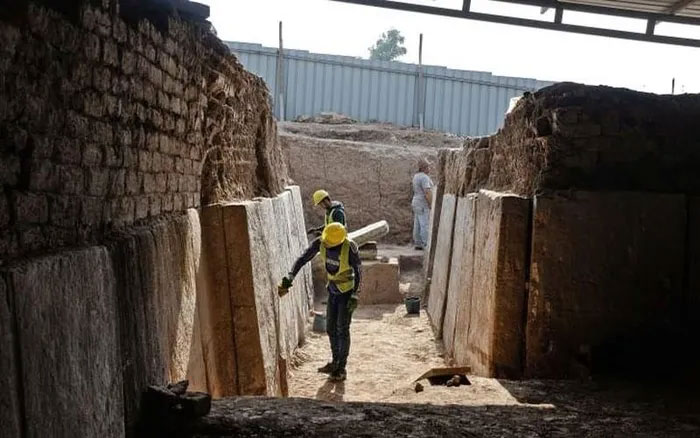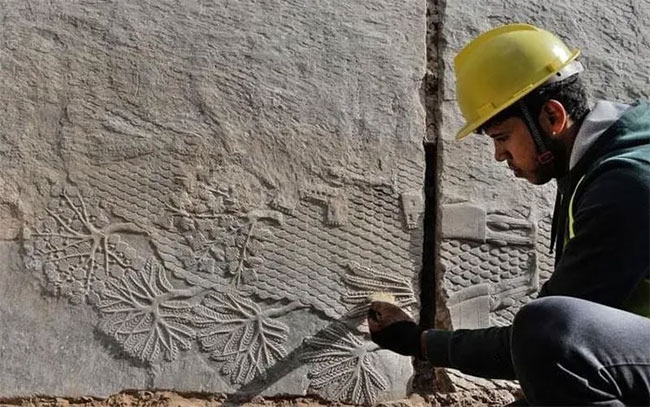An Iraqi worker has discovered an ancient Assyrian relief that has never been known before during excavations at the Mashki Gate, one of the massive gates leading to the ancient Assyrian city of Nineveh, now located in the outskirts of Mosul, Iraq.
Scientists estimate that this unique relief dates back approximately 2,700 years. This discovery was made by a team of American and Iraqi scientists while restoring the Mashki Gate, which had been destroyed by ISIS in 2016.
Iraq is home to some of the world’s oldest cities and earliest civilizations, including Babylon, Sumer, and Assyria. Around 700 BC, Assyrian king Sennacherib made Nineveh the capital and constructed the Mashki Gate, meaning “The Gate of God”, to guard the entrance to the city.

A section of the discovered reliefs. (Photo: CNN/AFP/Getty Images).

The restoration site of the Mashki Gate. (Photo: CNN/AFP/Getty Images)
However, this gate became one of many heritage sites that fell victim to prolonged military conflict and cultural vandalism in the region. The gate was rebuilt in the 1970s but was later demolished by ISIS soldiers using bulldozers during their occupation of Iraq. Throughout the occupation, archaeologist Michael Danti from the University of Pennsylvania led a project to protect and preserve cultural heritage in Iraq. He shared: “The Mashki Gate was one of the sites I reported on when ISIS destroyed it.”
When the Iraq Heritage Stabilization Program, initiated by Michael Danti, began the restoration of the Mashki Gate, they discovered stone carvings that Michael Danti described as “rare and unimaginable.”
Buried deep beneath the rubble of the Mashki Gate were seven intricately carved stone reliefs depicting Assyrian soldiers shooting arrows alongside palm trees, pomegranates, and figs—all belonging to Sennacherib’s palace.

The reliefs with carvings that are nearly intact. (Photo: CNN/AFP/Getty Images)
“We were all speechless at that moment. It felt like a dream. No one could have predicted that we would find a Sennacherib artifact at the Mashki Gate area,” said archaeologist Michael Danti.
Although the area had been excavated previously from the mid-1960s to the 1970s, no such discoveries were made. “These artifacts remained because they were buried,” he noted.
This new discovery has opened up new opportunities for research. Archaeologists have now returned to the city of Mosul to continue deeper excavations in search of more artifacts related to the Neo-Assyrian Empire.
Previously, artifacts discovered like this would have been taken abroad, such as to the British Museum or the Metropolitan Museum in New York, but these reliefs will remain in Iraq. “Access to cultural heritage is a human right, and groups like ISIS want to sever those connections forever as part of their cultural cleansing and genocide campaign,” stated archaeologist Michael Danti. He also mentioned that the Faida reliefs form a grand complex. The Assyrian royal family undertook a sculptural program to commemorate the advent of hydraulic systems that brought bountiful harvests to the surrounding countryside.
Some of the original carvings were discovered by British archaeologist Julian Reade in 1973 and have yet to be fully explored to this day.

















































